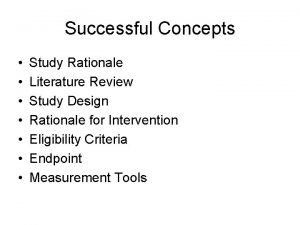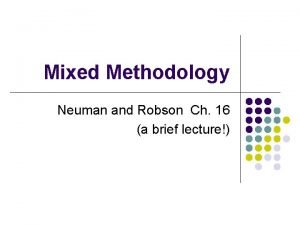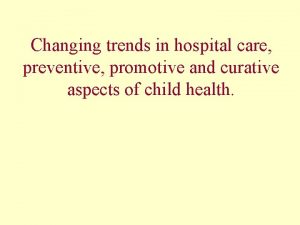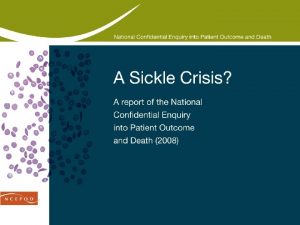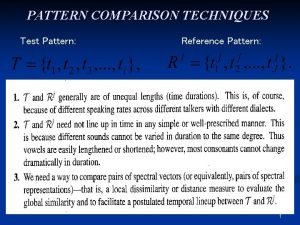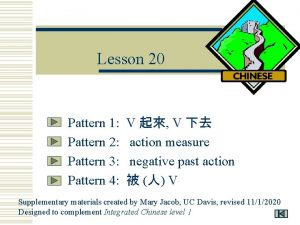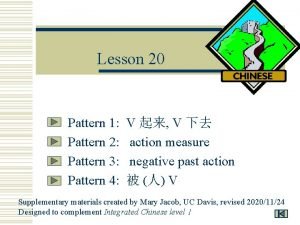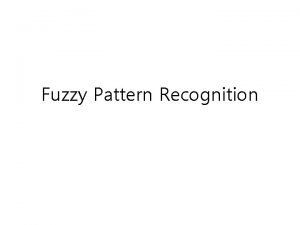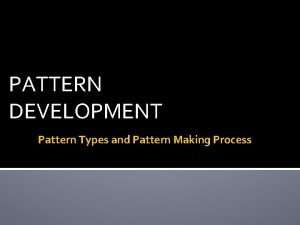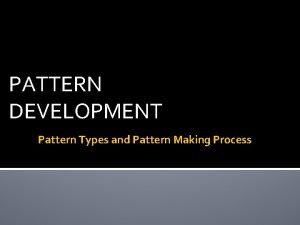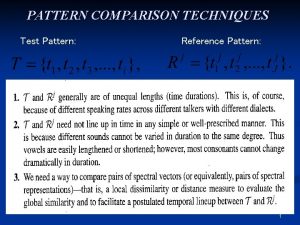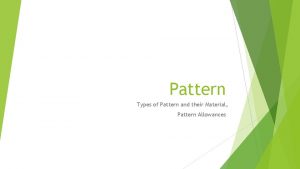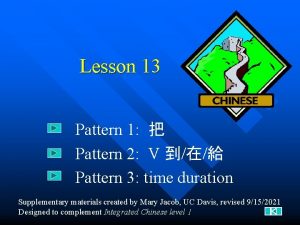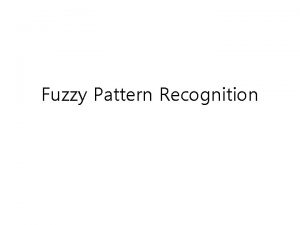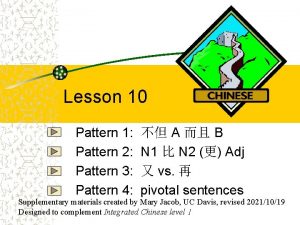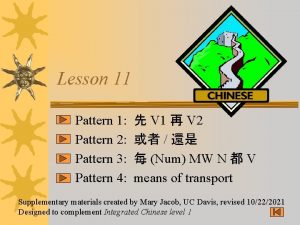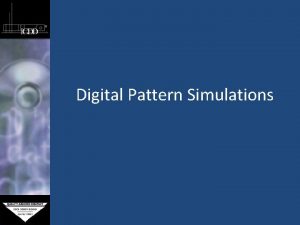Rationale for the study Changing pattern of care









































































- Slides: 73


Rationale for the study • Changing pattern of care in the UK • Developing protocols • New interventions • High birth incidence • Latest newborn screening figures predict between 1: 2000 and 1: 2500 • High rate of admissions • 13, 000 finished episodes in London 2005 -06 • Quality of autopsies • No previous national audits of deaths with casenote review

Study overview • All haemoglobinopathy deaths in the UK over a 2 year period • Data collection period • 1 st January 2005 – 31 st December 2006 • ICD-10 codes D 56 (Thalassaemia) and D 57 (Sickle Cell Disease) • Anywhere in diagnosis or cause of death • Adults and children • Hospital and community deaths

Inclusion criteria • Patients with the following haemoglobinopathies included: • Sickle cell anaemia (Hb. SS) • Sickle haemoglobin C (Hb. SC) • Sickle haemoglobin D (Hb. SD) • Sickle β-thalassaemia (Hb. S βThal) • β-thalassaemia major • β-thalassaemia intermedia • Exclusions – Patients with traits and no clinical symptoms

Study aims • Primary aim: to collect information on the care received by haemoglobinopathy patients who die in order to identify remediable factors in the care of these patients. Issues addressed included: • The organisation of outpatient management • Experience in managing haemoglobinopathies • Pain management • Mortality associated with surgery • Patterns of clinical pathology • The availability and use of local guidelines and protocols

Data collection • Semi structured questionnaire – 3 sections • The patient’s regular management • Final clinical episode • Organisation of care • Last 6 months medical notes • GP/specialist centre notes • Hospital casenotes • Autopsy reports (if available) • Guidelines and pathways – local and national • Expert opinion from advisors (assessment form)

Number of cases identified Denominator: 47 questionnaires; 55 casenotes

Exclusions • Of the 93 cases excluded, the majority were thalassaemia trait and asymptomatic sickle cell traits • High frequency with which this irrelevant data was entered onto death certificates indicates: • lack of understanding of clinical consequences of condition • lack of awareness of how to fill in death certificate • One very elderly patient with thalassaemia trait • thalassaemia listed in part 2 of death certificate • patient in fact died of cancer

Thalassaemia and sickle cell traits • Key finding: A disproportionately large number of cases with thalassaemia trait and sickle cell trait were reported to NCEPOD when the trait was not relevant. • Recommendation: In our multi-racial society, it is essential that all doctors should have a basic understanding of thalassaemia and sickle cell trait. (General Medical Council) • Recommendation: Sickle cell trait and thalassaemia trait should rarely be included on the death certificate; and if included this should only be after review by an individual who has experience in haemoglobinopathies. (Pathologists) • However, sickle cell trait is not always benign…

Sickle cell trait – case study 1 A young patient with sickle cell trait presented with haematuria and other kidney problems. Investigations showed that they had metastatic renal medullary carcinoma. The patient subsequently died. The advisors were of the view that this rare type of renal carcinoma is virtually restricted to those with the sickle gene, particularly Hb. AS, Hb. SC and occasionally Hb. SS. The prognosis for this carcinoma is very poor, and survival is less than one year from diagnosis.

Method of identification

• 31/55 patients male • 6 paediatric cases • Age range 1 to 77 years

Age of patients at death


Place of death • Hospital deaths most common • 41/55 died in hospital • 14/55 in community; 3 within 14 days of discharge • Of these 3, cause of death unknown in 2

Duration of final admission

Patterns of death - overview • Thalassaemia patients (n = 7) • Adult sickle cell disease patients (n = 40) • Hb. SC patient subset (n = 10) • Paediatric sickle cell disease patients (n = 6) • later in presentation with paediatric management • Sickle cell trait patients (n = 2) not included in this section on main patterns of death

Thalassaemia – patterns of death • 7 patients with thalassaemia died • 3 with thalassaemia intermedia (ages 39 -58) • 4 with thalassaemia major (ages 19 -32) • 2 died of complications of thalassaemia • 1 with cardiomyopathy • 1 with mucormycosis (co-morbidity diabetes) • Other 5 patients died of non-related causes • 2 died of cirrhosis • 1 of carcinoma of the lung • 1 with possible sepsis • 1 with no documented cause of death


Hb. SC adult patient subset • 10 patients with age range 26 -74 years • Only 2 had causes of death attributable to sickle cell disease • Intracerebral haemorrhage • pulmonary embolism • 5 patients died of unrelated causes • 1 each with brain tumour, diabetes and advanced HIV disease • 2 patients with severe systemic lupus erythematosus • co-incidental/pathogenic link? • 3 with unknown cause of death

NCEPOD grading of care • Good practice: A standard that you would accept from yourself, your trainees and your institution • Room for improvement: Aspects of clinical care that could have been better. • Room for improvement: Aspects of organisational care that could have been better. • Room for improvement: Aspects of both clinical care and organisational care that could have been better. • Less than satisfactory: Several aspects of clinical and/or organisational care that were well below satisfactory. • Insufficient information: Insufficient information available to assess the quality of care.



Type your headline here Regular management

Regular management • NCEPOD looked at the following aspects of regular management: • regular medications • antibiotic prophylaxis • vaccinations • location of patient management • outpatient appointments • medical advice and treatment • regular attenders • pain management (separate chapter)

Vaccination status

Vaccinations • Key finding: The clinicians managing the patients in this study only reported 15/47 as having received pneumococcal vaccine. • Recommendation: There needs to be clear recording of vaccination status by default; liaison between primary and secondary care is needed. (Primary and Secondary Care Trusts) • Recommendation: As a minimum, the Department of Health guidance regarding vaccination and prophylactic antibiotics should be followed in order to prevent sepsis from hyposplenism. (Primary Care Trusts)

Outpatient management • Outpatient management took place in specialist centres, GP surgeries and non-specialist centres • 28/47 patients attended outpatients • 12 of these were reported to attend irregularly • 11/55 patients showed a reluctance to attend outpatients • In 4 cases it was judged to have had an impact on outcome • Further 3 cases with insufficient information to comment

Refusal to accept advice • In 8/14 patients who refused advice/treatment, the advisors considered that it could have had impact on outcome • e. g. thalassaemic patient refusing advice to increase chelation

Type headline here Painyour management

Pain management • Pain is the most frequent problem experienced by individuals who have sickle cell disease (SCD) and has a major impact on quality of life. • Good pain management is a key requirement for the care of sickle cell patients • Many complicating factors for both clinicians & patients • Guidelines exist for acute painful crisis management British Journal of Haematology, 2003, 120, 744– 752 • NCEPOD reviewed • Ongoing pain management • Acute pain management

Ongoing pain management • Of the 40 sickle cell disease patients for whom a questionnaire was returned, 14 took regular pain medications for ongoing pain management • In the opinion of the advisors, in six patients there was evidence of dependency issues; however in 13 patients there was insufficient information from the casenotes to form an opinion • In general, there was a lack of a multidisciplinary or multiagency approach to the management of opioid dependency in these sickle cell disease patients

Pain management - case study 5 A young patient with sickle cell disease was known to have a drug dependency and was receiving opioids on a regular basis. They sought help from a sickle cell centre. The patient was allowed to leave the clinic before arrangements had been made for them to be seen by a psychologist working for the drug dependency team. The patient did not return to the clinic and their body was discovered some two weeks later. • Allowing patient to leave before support had been organised may have contributed to the subsequent tragic events. • The quality of the autopsy was poor. Noteworthy that “a white substance was found in the stomach and in the trachea”. It is most likely that this person had vomited and died from aspiration of vomit. It was likely that this was directly due to opioid misuse.

Acute pain management • Of the 35 sickle cell disease patients who died in hospital, 19 had pain as an admitting complaint. • In 13 of these patients there was lack of evidence that pain or the adverse effects of opioids were formally assessed on a regular basis. • Of those patients who did have pain or adverse effects monitored, the frequency of observations was inadequate

Acute pain management • In 9/19 of the patients admitted with pain, excessive doses of opioids were given • In 5 patients where complications occurred due to overdose this contributed to the ultimate death • In 7 of the patients who received excessive doses of opioids there was lack of knowledge regarding acute pain management and inadequate clinical review of the escalating analgesic requirements • In all of these, junior trainee medical staff were responsible for the prescribing of analgesia and no apparent attempt was made to seek advice from consultants in haemoglobinopathies or acute pain management.

Acute pain management – case study 6 Middle aged patient with Hb. SC admitted via the emergency department - back and leg pain of 24 hours duration • patient was not taking any regular analgesia • initially given diclofenac and co-codamol according to a local sickle cell crisis analgesia regimen • minimal improvement in the pain Prescribed 50 mg of pethidine IM 4 hourly post-admission followed by 100 mg 2 hourly by a pre-registration house officer No evidence of formal assessment or documentation of pain. Following evening, SHO was asked to insert an intravenous cannula for fluid administration • found the patient unresponsive • could not be resuscitated

Case study 6 – advisors’ opinion • This opioid naïve patient had received 1500 mg of pethidine in the 24 hours leading up to their death which was thought to be excessive • The patient should have had more frequent observations of the level of sedation and respiratory rate which reflected the increasing doses of opioids • There was lack of senior medical staff involvement in this patient’s care • The opioid overdose was a probable contributing factor to this patient’s death which could have been avoided. Despite an autopsy, there was no convincing clinical pathology

Pain recommendations • Recommendation: A multidisciplinary and multi-agency approach is needed in the ongoing pain management of patients with sickle cell disease – essentially this takes place outside hospitals for the majority of patients. (Primary and Secondary Care Trusts) • Recommendation: Regular assessment of acute pain, sedation and respiratory rate should be undertaken and recorded for all patients admitted with sickle cell disease. The frequency of these observations should reflect the degree of pain and dose of opioids administered, to allow recognition of opioid overdose. The development of “track & trigger” systems would greatly enhance better pain control and patient safety. (Clinical Directors)

Final clinical management

Final clinical management • NCEPOD looked at the following aspects of management in the final clinical episode: • Stroke • Acute chest syndrome • Pulmonary embolism & hypertension • Sepsis • Iron overload and cardiac death • Renal failure • When sickle is not the main problem • Surgery and peri-operative care • Pregnancy • Paediatric patients • Nursing care • Other issues – protocols/education


Stroke • Stroke was the commonest complication, leading to death in 9 patients • All the formally diagnosed cases in adults were haemorrhagic • May have been some ischaemic cases, but this was not possible to determine • No guidelines for the prevention of stroke in adults at present, as it is less tractable, but there are for children

Acute chest syndrome (ACS) • 2 cases where ACS was listed as primary cause of death • 3 further cases where it was likely contributor or part of multi-organ failure • No documented cases in children, although a recognised cause of death in paediatric patients • Recommendation: Acute chest syndrome is a major cause of morbidity and mortality in patients with sickle cell disease. Management of patients with this complication should be according to local protocols and early advice from specialists in essential. (Primary and Secondary Care Trusts)

Pulmonary embolism & hypertension • 2 patients died of massive pulmonary embolism • Both diagnosed at autopsy • Advisors commented on potential difficulties associated with diagnosis • Especially chronic progressive lung disease • Recommendation: Chronic sickle chest disease is an expanding, complicated area and requires more careful correlation of pre-mortem clinical, physiological and imaging data with autopsy pathology. (Clinicians and Pathologists)

Renal failure • People with sickle cell disease are known to be particularly prone to developing kidney failure • May be due to damage to: • the renal glomerulus by the sickle process • sickling in the medullary vessels – papillary necrosis • infection • the use of non-steroidal anti-inflammatory drugs • No one dying in hospital was recorded as having renal complications of sickle cell disease as a cause of death • one patient with chronic disease allowed to die at home • one patient in which renal failure potentially overlooked • Care associated with examples of very best and very worst care

Renal failure – case study 12 Young patient admitted with breathlessness, anaemia and urea of 27 mmol/L. Comment in notes that serum creatinine should be measured before decision made re: renal failure • no evidence that this was followed up Breathlessness diagnosed as ACS • review by chest physician doubted this; suggested fluid overload • again, no follow up of renal function A little later, patient died of cardiac arrest • blood gas sample potassium result led to a diagnosis of ‘hyperkalaemic cardiac arrest’

Case study 12 – advisors’ opinion • The advisors considered this to be an unexpected death. • There was a review of the case, but no-one appeared to have noted the initial high blood urea resulted. • It was evident that the patient has had renal failure on admission which was not reconsidered. • The focus appeared to have been on the chest problems and adequate attention was not paid to the complete picture.

A different problem – case study 13 A young adult patient was thought to have an acute sickle cell crisis, but with rather atypical features. There did not appear to be a good response to standard treatment and the clinicians later reconsidered the working diagnosis. Further investigations showed the patient was HIV positive, with end-stage disease, which fitted better with the clinical scenario. The advisors commented that had it not been for the sickle cell disease, it is likely that the problem would have been recognised more promptly. Hb. SC appears to have stopped the clinicians thinking beyond the patient’s sickle cell disease.

When sickle is not the main problem Key finding: Patients with sickle cell disease can have other conditions which can be misattributed to sickle cell disease. Recommendation: All staff should be aware that people with sickle cell disease re subject to the diseases that other patients suffer from as well. If there is uncertainty as to whether the problem is sickle cell related, advice should be sought from an experienced clinician. (Primary and Secondary Care Trusts)

Surgery and peri-operative care • 9/41 patients underwent surgery • Seniority and experience of surgeon and anaesthetist • considered to be sufficiently experienced in 4 cases • insufficient data to judge in remaining 5 cases • 7 patients experienced peri-operative complications • considered to be avoidable in 4 cases • worsening liver failure and ascites, massive cerebral infarct, massive bleed and post-operative sepsis • Key finding: There were fewer surgical cases submitted than were anticipated. NCEPOD is also aware of the ongoing study of pre-operative blood transfusion.

Paediatric patients • Life-long inherited conditions • 6 paediatric patients (ages 1 -15 years) • 2 youngest had significant non-sickle comorbidities • 2 older children died of cerebrovascular events diagnosed as subarachnoid haemorrhage • 1 died of pneumococcal sepsis and crisis • 1 had no cause of death • 3 of the cases were community deaths • In some cases, the underlying diagnosis of sickle cell disease appeared to have caused confusion or delayed the correct diagnosis • example of this in case study 15

Paediatric case – case study 15 Adolescent with Hb. SS disease developed headache and vomiting • regularly taking penicillin and folic acid • neck stiffness, but no fever • differential diagnosis – sickle crisis or meningitis • given more antibiotics, but no record of lumbar puncture Symptoms persisted and CT ordered the next day • initial report was normal, but review by neurosurgical centre review showed subarachnoid haemorrhage Patient transferred to neurosurgical centre, cerebral aneurysm demonstrated and had exchange transfusion • intracerebral bleed, acute hydrocephalus and shunt insertion followed Two weeks later stent and coil embolisation performed, but patient deteriorated and died.

Case study 15 – advisors’ opinion • The advisors commented on the delay in considering an intracranial haemorrhage – a standard complication of sickle cell disease in children – and in obtaining a brain scan. • They also considered there appeared to be a delay in stenting the abnormal artery. • In general, advice and involvement from professionals with experience in the management of haemoglobinopathies in children should be sought early.

Nursing care • Overall nursing management was good. • However, there was room for improvement in some areas: • The need to document all observations and actions accurately • Reporting and acting on abnormal observations • Understanding the potential side effects of medications, especially opioids • Importance of fluid balance and strict recording of input and output

Fluid balance • A lack of understanding of the importance of hydration which was seen in some cases • Of the 41 patients who died in hospital: • 21 had good and adequate fluid balance management • 7 had poor fluid balance management • 13 cases with insufficient information to comment • Failure to monitor fluid intake and output, contributing to deterioration in patient’s condition • Recommendation: All sickle cell disease patients should have a carefully maintained fluid balance chart for the duration of their admission. (Nurses)

Organisation of care

Organisation of care • NCEPOD looked at the following aspects of organisational care: • Clinicians • specialty • seeking advice • Hospitals and wards • Hospital facilities • Protocols and guidelines

Clinicians • Patients have unique health problems and healthcare needs • Patients in hospital often require review by multiple specialties and sometimes referral to additional services • Patients still admitted under a named consultant • 10 admitted under haematology • 10 admitted under general medicine • Only 2/41 patients considered to be admitted under inappropriate clinician and not transferred to appropriate clinician before death

Seeking advice – case study 20 A specialist registrar made the decision to stop the warfarin in a young patient with a history of pulmonary embolism who was undergoing eye surgery for cataract. There was no consideration given to starting heparin post operatively. The patient developed a post operative pulmonary embolus and died. The advisors believed that there should have been a haematology consultant involved in the complicated decisions around the patient’s anticoagulation therapy. There ought to have been a way around this problem of prophylaxis.

Clinicians - recommendations • Recommendation: Patients with sickle cell disease or beta thalassaemia major should be managed by, or have access to, clinicians with experience of haemoglobinopathy management. (Primary and Secondary Care Trusts) • Recommendation: All haemoglobinopathy patients should have a named specialist, ideally a haematologist, responsible for their care. The haematologist must have an appropriate level of expertise to care for the patient or should make links with appropriate experts. (Primary and Secondary Care Trusts)

Available guidelines 47 questionnaires were returned, representing 26 different sites

Protocols and guidelines • Only 4/26 sites had a care pathway for haemoglobinopathy patients • 8 sites did not have separate guidelines for the management of paediatric and adult patients • However, 2 of these sites were paediatric centres • Less than a third (8/26) had agreed policies for the transfer of patients to other hospitals • Recommendation: Healthcare centres responsible for the management of patients with haemoglobinopathies should have access to protocols/guidelines from regional specialist centre. (Primary and Secondary Care Trusts)

Death certification and autopsies

Death certification and autopsies • NCEPOD reviewed death certification and autopsy diagnoses. • The following are addressed in this presentation: • Advisors’ agreement with cause of death • Incorrect death certification • Autopsies • number of autopsies • example of an excellent autopsy • example of the failure to perform histology • Key findings and recommendations

Death certification • The cause of death was determined from the casenotes or the clinician questionnaire. • Of the 43 cases where the cause of death could be determined, the advisors considered 22 to be correct

Incorrect death certification • Reasons for incorrect death certification included: • Failure to include sickle cell disease on the death certificate • Incorrect ordering of contributing factors • Failure to include operation details • In the following cases, there was a misunderstanding of the correct way to complete a death certificate: 1 a Sickle cell disease 1 b Severe haemolytic anaemia 1 c Cardiorespiratory arrest • And this was not restricted to clinicians, a pathologist wrote: 1 a Cardiomegaly 1 b Sickle cell disease 2 Hepatomegaly

Autopsies • 21/55 patients had an autopsy of which 20 were coronial • In 5 cases where no autopsy was performed, the advisors believed that an autopsy was necessary to confirm the cause of death • 15 autopsy reports were returned to NCEPOD • The overall standard of autopsies was poor, although there were some excellent reports (case study 21) • Of the 13 adult autopsy reports, the advisors: • Agreed with the autopsy diagnosis in 4 cases • Disagreed with the autopsy diagnosis in 3 cases • Could not make a definitive decision in 6 cases

Excellent autopsy – case study 21 A young adult suffered a pulmonary embolism secondary to deep vein thrombosis. Full histology was undertaken which documented the bone necrosis present and the changes of pulmonary hypertension, both significant problems clinically. In addition, toxicology was undertaken as the death occurred soon after administration of diamorphine. A therapeutic level of diamorphine, in keeping with the administered dose, was confirmed. The advisors reported that clinico-pathological correlation went on to describe that deep vein thromboses and pulmonary embolisation were not common problems in sickle cell disease patients.

Histology – case study 24 A middle-aged patient was admitted with painful sickle crisis and was being treated as per the hospital protocol. All observations were normal. The patient suffered an unexpected cardiac arrest. On morphological appearances of the kidney alone, with no confirmatory histology, the pathologist gave the cause of death as renal failure due to papillary necrosis. The bladder was full of urine, and throughout the admission the renal function was measured as normal. It was the opinion of the advisors that the patient could not have died from renal failure secondary to papillary necrosis with investigations showing normal electrolytes and renal function only a few hours prior to death. The real cause of death may have been acute chest syndrome.

Specialist autopsy pathology • Pathologists and clinicians have problems in correctly correlating the sequence of events that lead to death • Royal College of Pathologists guidelines (2005) to aid process • Key finding: Deaths in sickle cell disease patients were not well evaluated and depicted. • Recommendation: Cause of death in sickle cell disease patients must be better evaluated, whether by clinicians reviewing the records and writing a death certificate or by pathologist performing an autopsy. Clinico-pathological correlation is critical in this complex disease. (Clinicians and Pathologists)

Summary and comment

Summary and comment • Throughout this presentation, the following have been addressed: • Monitoring patients • Clinical networks • Development of national guidelines • Pain control • Autopsy evaluation and causes of death • and…. .

National database • In nearly half of cases, the actual cause of death was debatable or unknown • If this small series is representative, it amounts to a wakeup call to the haemoglobinopathy clinical community: less is known about severe complications than previously thought • Prompts conclusion that a national database is needed • Recommendation: A national database of patients with haemoglobinopathies should be developed and maintained, to include standardised information on death, for regular audit purposes. (Department of Health)
 Literature review rationale
Literature review rationale Sample rationale of the study
Sample rationale of the study Content of a research proposal
Content of a research proposal Levels of nursing care primary secondary tertiary
Levels of nursing care primary secondary tertiary Preventive promotive and curative aspects of health
Preventive promotive and curative aspects of health Fspos vägledning för kontinuitetshantering
Fspos vägledning för kontinuitetshantering Typiska drag för en novell
Typiska drag för en novell Tack för att ni lyssnade bild
Tack för att ni lyssnade bild Returpilarna
Returpilarna Varför kallas perioden 1918-1939 för mellankrigstiden
Varför kallas perioden 1918-1939 för mellankrigstiden En lathund för arbete med kontinuitetshantering
En lathund för arbete med kontinuitetshantering Personalliggare bygg undantag
Personalliggare bygg undantag Personlig tidbok fylla i
Personlig tidbok fylla i Anatomi organ reproduksi
Anatomi organ reproduksi Förklara densitet för barn
Förklara densitet för barn Datorkunskap för nybörjare
Datorkunskap för nybörjare Stig kerman
Stig kerman Mall för debattartikel
Mall för debattartikel Magnetsjukhus
Magnetsjukhus Nyckelkompetenser för livslångt lärande
Nyckelkompetenser för livslångt lärande Påbyggnader för flakfordon
Påbyggnader för flakfordon Formel för lufttryck
Formel för lufttryck Offentlig förvaltning
Offentlig förvaltning Jag har nigit för nymånens skära
Jag har nigit för nymånens skära Presentera för publik crossboss
Presentera för publik crossboss Vad är ett minoritetsspråk
Vad är ett minoritetsspråk Vem räknas som jude
Vem räknas som jude Klassificeringsstruktur för kommunala verksamheter
Klassificeringsstruktur för kommunala verksamheter Fimbrietratt
Fimbrietratt Claes martinsson
Claes martinsson Centrum för kunskap och säkerhet
Centrum för kunskap och säkerhet Verifikationsplan
Verifikationsplan Mat för idrottare
Mat för idrottare Verktyg för automatisering av utbetalningar
Verktyg för automatisering av utbetalningar Rutin för avvikelsehantering
Rutin för avvikelsehantering Smärtskolan kunskap för livet
Smärtskolan kunskap för livet Ministerstyre för och nackdelar
Ministerstyre för och nackdelar Tack för att ni har lyssnat
Tack för att ni har lyssnat Referatmarkering
Referatmarkering Redogör för vad psykologi är
Redogör för vad psykologi är Stål för stötfångarsystem
Stål för stötfångarsystem Tack för att ni har lyssnat
Tack för att ni har lyssnat Borra hål för knoppar
Borra hål för knoppar Vilken grundregel finns det för tronföljden i sverige?
Vilken grundregel finns det för tronföljden i sverige? Formel gruplar
Formel gruplar Tack för att ni har lyssnat
Tack för att ni har lyssnat Steg för steg rita
Steg för steg rita Verksamhetsanalys exempel
Verksamhetsanalys exempel Tobinskatten för och nackdelar
Tobinskatten för och nackdelar Toppslätskivling effekt
Toppslätskivling effekt Modell för handledningsprocess
Modell för handledningsprocess Egg för emanuel
Egg för emanuel Elektronik för barn
Elektronik för barn Fredsgudinnan
Fredsgudinnan Strategi för svensk viltförvaltning
Strategi för svensk viltförvaltning Kung dog 1611
Kung dog 1611 Indikation för kejsarsnitt på moderns önskan
Indikation för kejsarsnitt på moderns önskan Sju för caesar
Sju för caesar Tack för att ni lyssnade
Tack för att ni lyssnade Avrunda decimaltal
Avrunda decimaltal Rim dikter
Rim dikter Inköpsprocessen steg för steg
Inköpsprocessen steg för steg Rbk-mätning
Rbk-mätning Etik och ledarskap etisk kod för chefer
Etik och ledarskap etisk kod för chefer Expektans
Expektans Myndigheten för delaktighet
Myndigheten för delaktighet Trög för kemist
Trög för kemist Sju principer för tillitsbaserad styrning
Sju principer för tillitsbaserad styrning Läkarutlåtande för livränta
Läkarutlåtande för livränta Karttecken punkthöjd
Karttecken punkthöjd Lek med geometriska former
Lek med geometriska former Vishnuismen
Vishnuismen Meios steg för steg
Meios steg för steg Bris för vuxna
Bris för vuxna
